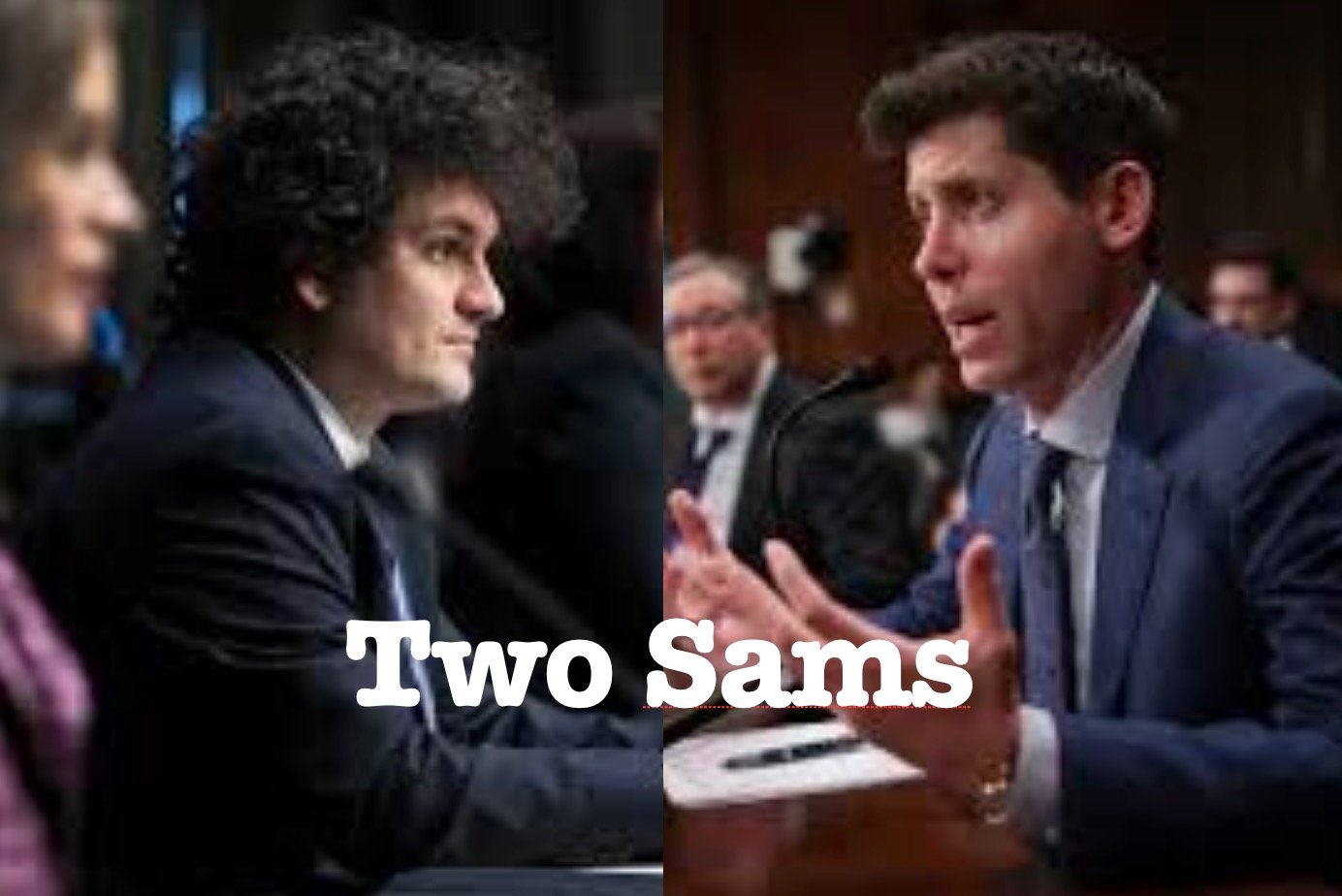Two Sams: SBF, Altman, and How AI Can Overdeliver
Sam’s black hoodie set him apart from the models, moguls, and millionaires at the invite-only affair in New York’s Hudson Yards. They hovered around him asking to take selfies or if he would listen to their startup idea. He had just flown in from Hong Kong. The next day he traveled to Washington DC where he testified before Congress. He was encouraged by the warm, bipartisan reception he received at the Capitol. “I think there can be a regulatory framework that can help build a really strong industry while also providing oversight and consumer protection.” he said in an interview afterwards.
Sam’s estimated net worth was $22bn and he wasn’t even 40. But he planned to give it all away through something he called “effective altruism.”
But, which Sam are we talking about? Sam Altman, who testified before Congress last week? Or Sam Bankman-Fried who testified before Congress in 2021, and now awaits sentencing inside a Brooklyn jail?
The description above is the Sam Bankman-Fried that emerges in Zeke Faux’s hard-hitting new book “Number Go Up: Inside Crypto's Wild Rise and Staggering Fall.” It is a sobering illustration of what happens when the actual value of innovation is dangerously distorted by its hype.
The book made me think about how Sam Altman and AI can do better than SBF and crypto. With every exciting technology there is signal and noise, data and dogma, value and valuation. This was true with crypto, tulip bulbs, and subprime mortgages packaged. It is equally true with AI.
Source: SimilarWeb
To live up to its promise AI needs to graduate from retail to enterprise.
There are signs that generative AI may have already saturated its primary market. Monthly usage of CHAT GPT declined for three straight months beginning in May. Everyone who writes content, creates designs, or needs to write a formulaic message or essay is already using CHAT GPT. Industries which generally end with the term ‘agency’ like PR agencies, design agencies, software development agencies, advertising agencies have all been affected by generative AI.
Can generative continue to grow in the domain of content creation? Absolutely. But this market with only 116.7bn in aggregate 2023 revenue cannot sustain the enormous valuations that generative AI startups command.
For AI to live up to its promise it has to graduate from viral and small to boring and big. It needs to transform huge enterprises where executives are called “partners.” These industries are law firms, investment banks, management consultancies, and insurers. I’ve worked in these industries and can attest that they are slow, inefficient, and badly need AI. Thousands of their employees are smart, Ivy league graduates who spend 100 hours a week copying numbers from a PDF file, pasting them into an excel model, and using the charts to create a PowerPoint deck.
But, even though the Partner Industries are slow, heavily regulated, and digitally outdated, they’re huge and have never been disrupted. Collectively these industries are about 3.6x the size of AI’s current addressable market.
To graduate from retail to enterprise generative AI needs to overcome three huge challenges.
The ‘language’ that Large Language Models are trained on is all in the public domain.
To graduate into the “Partner” industries LLMs need to ‘learn’ from highly confidential and protected data from legal cases, M&A due diligence, and thorny corporate problems that consultants help resolve. Many of these companies can’t or won’t share that data. Data privacy and security will be a critical precondition for even starting to train generative AI. “We forget that AI has been around for a long time and has struggled to make meaningful inroads into law, healthcare, consulting, and banking. Because people consistently underestimate how carefully guarded the data is.” said Ian Cook, CTO of Seek, and a 20-year AI veteran.
Nicole Reineke, Co-Founder of Shift5.ai is optimistic. “We’re about to see AI explode in law, healthcare and government, because new model releases enable you to go to the exact document, and page number so the user can make a more informed decision about the data’s source and credibility.”
Another challenge is obstructionism. The Partner industries are run by men (mostly) who range from skeptical to obstructionist when it comes to emerging technology. (Walk around a law firm at midnight and look at the technology they use. You’ll see what I mean). Many of these leaders are extremely risk averse. Their risk aversion was earned honestly - by getting hauled in front of regulators and seeing what happened at Lehman, Arthur Andersen, and Merill Lynch. They also have no qualms sabotaging hot young tech talent who might get promoted before them. It’s gross - but it happens all the time. Office politics is injected with steroids in banking and law.
The executives leading the fastest growing AI startups have a clear resume deficit: they’ve never worked in the industries where AI needs to expand. At least not for very long. This might change because of the Entrepreneur Exodus - the executives from Goldman Sachs, Morgan Stanley, McKinsey and Bain, who are leaving to launch new ventures or work in Big Tech. (We wrote about Wall Street’s tech talent exodus here.) These are the technologists who know exactly who the customers, regulators, and investors are in the Partner industries. They know exactly how they can be served better, faster, and smarter with AI. This needs to be an intentional strategic talent investment by OPEN AI, Microsoft, Amazon, Anthropic, etc…. So far, it only seems intentional at Amazon.
I’m skeptical that generative AI can graduate to the Partner industries. These following things would change my mind:
More Partner industry executives have backgrounds as CIOs and CTOs, or executives from tech companies rather than accountants, MBAs, or lawyers.
When the Partner industries acquire tech companies they let them lead. There is not a mass departure of the acquired company’s talent immediately afterward.
OPEN AI, Amazon, Google, Microsoft, and Anthropic starts to poach top tech talent from the Partner industries. And then starts poaching their biggest clients. (This transformation has already taken hold in the pharmaceutical industry. AI experts left incumbents like Merck and Pfizer and started to steal market share, forcing the incumbents to transform.)
Generative AI will need to graduate from its anchor agency and retail market to a much bigger, harder to crack enterprise market in order to live up to its full growth potential. In order for Sam Altman to fulfill his exciting promise and not suffer the same fate as SBF. It will be extremely hard. The Partner industries are resistant to change, and they are beset by data privacy rules which will make it extremely difficult to share the information needed to train the AI. But Sam Altman has already achieved growth that many of us thought was impossible. There is cause for cautious optimism.
DON’T FORGET! This Friday Sept. 22 is the last chance to apply to become one of the next 25 members of Punks & Pinstripes.
Y’all are my heroes,
Greg Larkin
Founder, CEO, Punks & Pinstripes
If you like this article, please:
Subscribe and share it.
The next opportunity to become a member of Punks & Pinstripes is Sept. 8 - 22. We only accept 25 new members during a 2-week application period every quarter, and membership is capped at 200.





